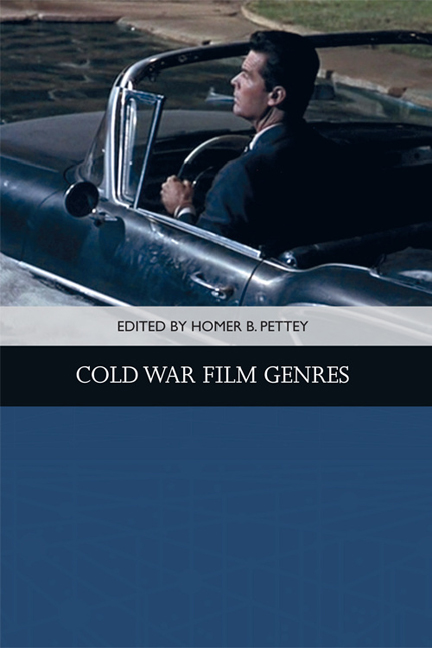Book contents
- Frontmatter
- Contents
- List of Illustrations
- Acknowledgments
- Notes on the Contributors
- 1 Introduction: Cold War Genres and the Rock-and-Roll Film
- 2 Social Factors in Brainwashing Films of the 1950s and 1960s
- 3 The Berlin Crisis? Piffl!: Billy Wilder’s Cold War Comedy, One, Two, Three
- 4 The Small Adult Film: A Prestige Form of Cold War Cinema
- 5 “I’m Lucky – I Had Rich Parents”: Disability and Class in the Postwar Biopic Genre
- 6 Rogue Nation, 1954: History, Class Consciousness, and the “Rogue Cop” Film
- 7 Internal Enmity: Hollywood’s Fragile Home Stories in the 1950s and 1960s
- 8 Suburban Sublime
- 9 Domestic Containment for Whom? Gendered and Racial Variations on Cold War Modernity in the Apartment Plot
- 10 Success and the Single Girl: Urban Romances of Working Women
- 11 Paris Loves Lovers and Americans Loved Paris: Gender, Class, and Modernity in the Postwar Hollywood Musical
- 12 Straight to Baby: Scoring Female Jazz Agency and New Masculinity in Henry Mancini’s Peter Gunn
- Index
12 - Straight to Baby: Scoring Female Jazz Agency and New Masculinity in Henry Mancini’s Peter Gunn
Published online by Cambridge University Press: 24 April 2021
- Frontmatter
- Contents
- List of Illustrations
- Acknowledgments
- Notes on the Contributors
- 1 Introduction: Cold War Genres and the Rock-and-Roll Film
- 2 Social Factors in Brainwashing Films of the 1950s and 1960s
- 3 The Berlin Crisis? Piffl!: Billy Wilder’s Cold War Comedy, One, Two, Three
- 4 The Small Adult Film: A Prestige Form of Cold War Cinema
- 5 “I’m Lucky – I Had Rich Parents”: Disability and Class in the Postwar Biopic Genre
- 6 Rogue Nation, 1954: History, Class Consciousness, and the “Rogue Cop” Film
- 7 Internal Enmity: Hollywood’s Fragile Home Stories in the 1950s and 1960s
- 8 Suburban Sublime
- 9 Domestic Containment for Whom? Gendered and Racial Variations on Cold War Modernity in the Apartment Plot
- 10 Success and the Single Girl: Urban Romances of Working Women
- 11 Paris Loves Lovers and Americans Loved Paris: Gender, Class, and Modernity in the Postwar Hollywood Musical
- 12 Straight to Baby: Scoring Female Jazz Agency and New Masculinity in Henry Mancini’s Peter Gunn
- Index
Summary
People want to be smart, and when they listen to jazz with a modern story, they start to get the feeling, even though they don't know what they are doing. Any emotion can be inspired by jazz. It has a lot of sexual drive, and this is one way TV can employ sex in its stories without being questioned by the censors.
Henry ManciniMancini intuited that he could write for the five or six players who might be pictured in a club scene and bring that music forward sometimes to take on the responsibilities of narrative scoring, with extensions, digres-sions, builds, and climaxes that matched the action on screen. He would use jazz in a storytelling capacity.
INTRODUCTION
Three cultural dispositifs gain currency in jazz-informed media of the 1950s. The first is the rising visibility of the West Coast jazz musician after the success of Henry Mancini's crime jazz series Peter Gunn. The second and third relate to alternative gender stagings occurring within American culture resulting from a variety of jazz-informed media. The late 1950s, in particular, witnessed an unorthodox representation of the white working woman through what I shall categorize as a female jazz agency. The last but perhaps more restricting dispositif supported the image of the so-called new man, and the attendant notions of ‘new masculinity’ connected to both jazz connoisseurship and a liberal sex politics presented in jazz-informed entertainment media, especially Mancini's Peter Gunn.
While important scholarship within film music studies uncovers much of the unique aesthetic and musical strategies developed by Mancini and others in the postwar period, few scholars have examined the ways in which Mancini's music incorporated creative techniques to both reinforce and transgress accepted gendered representations within the crime detective and noir genre. Many argue that his hybrid compositional practices, which incorporated non-traditional music genres and especially jazz and popular music, were so com¬pelling that they had a profound impact on film scoring from the 1960s on. Yet most fail to interrogate how this captivating and flexible style affected our understanding of gender and sexuality at the cusp of the 1960s, an era emblemized by its progressive transformations within sociopolitical fields.
- Type
- Chapter
- Information
- Cold War Film Genres , pp. 228 - 258Publisher: Edinburgh University PressPrint publication year: 2018



